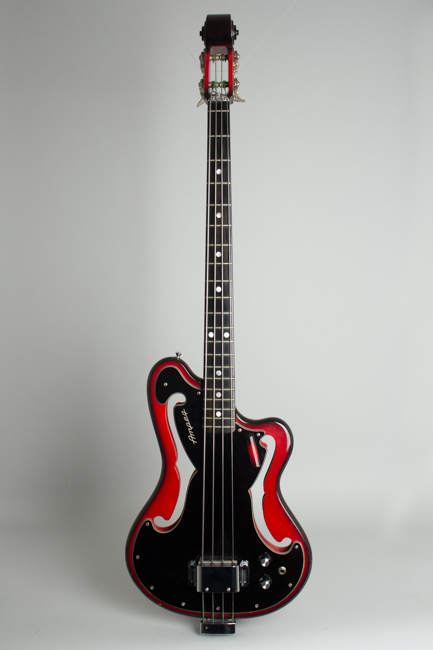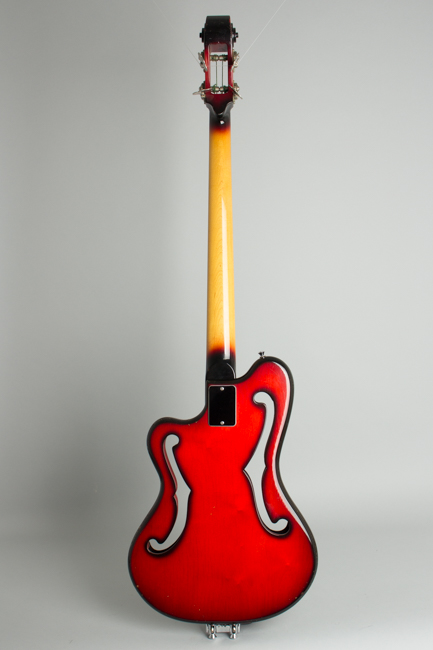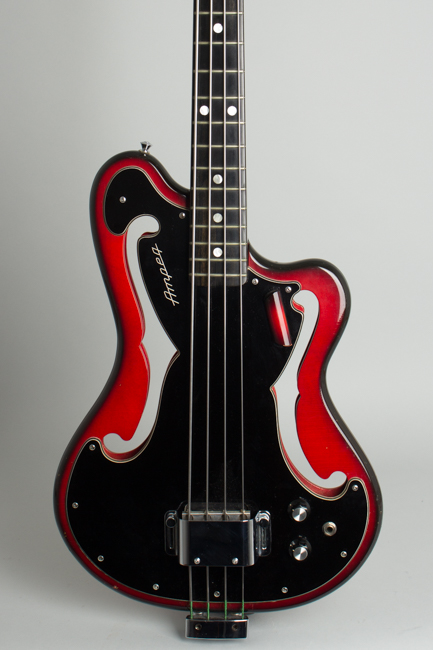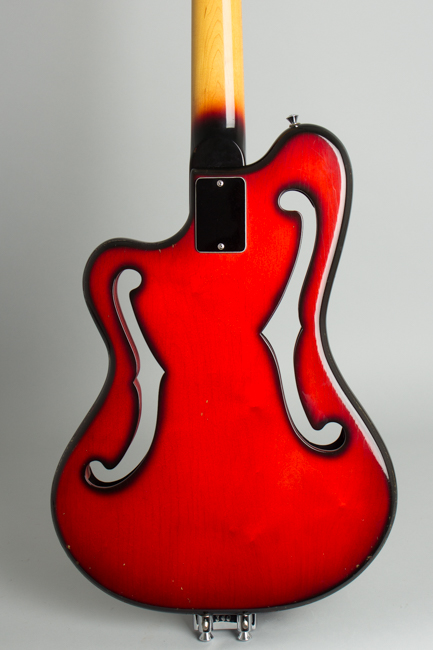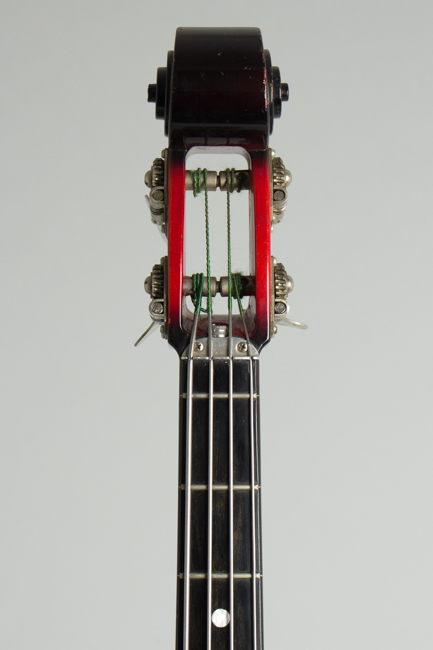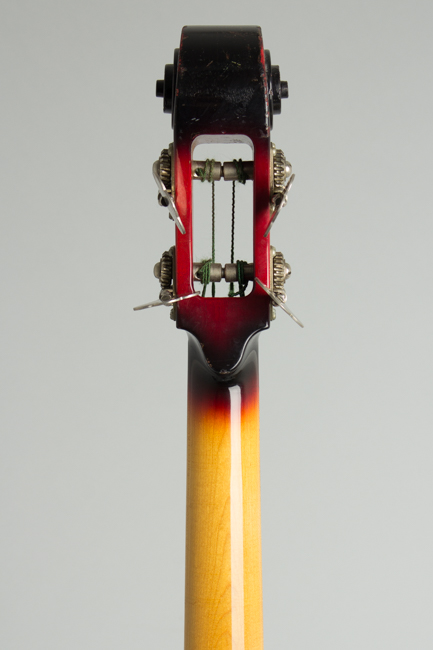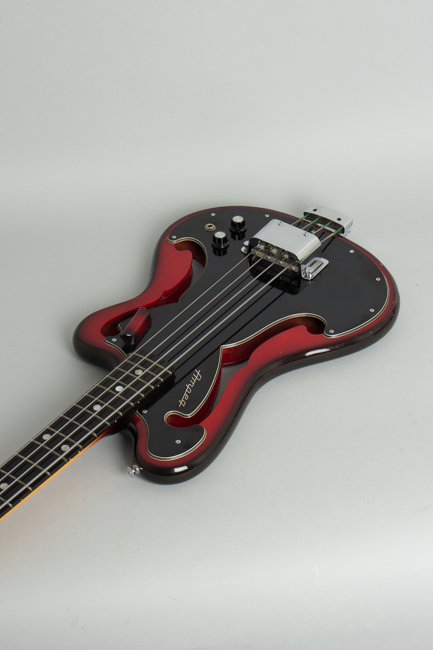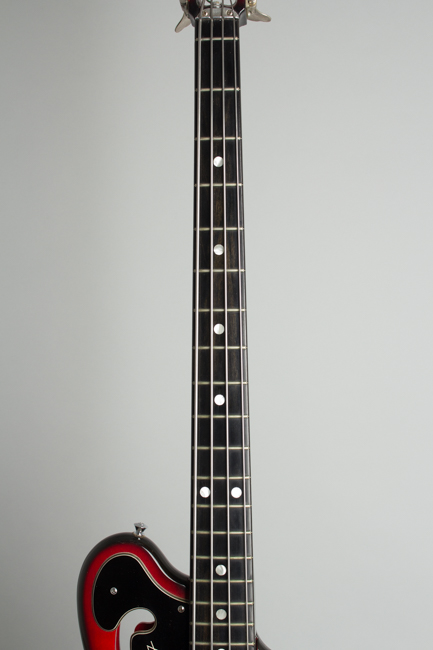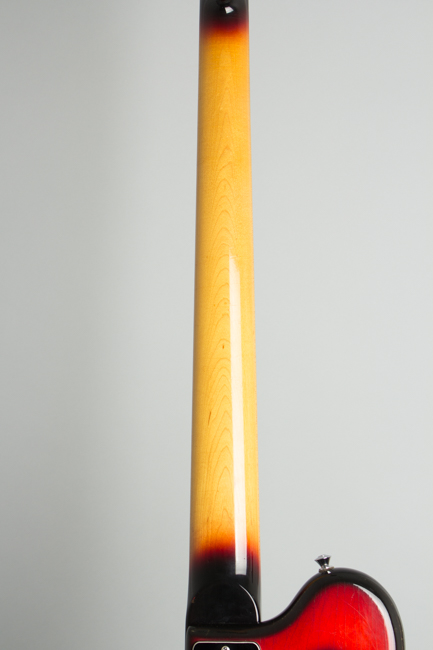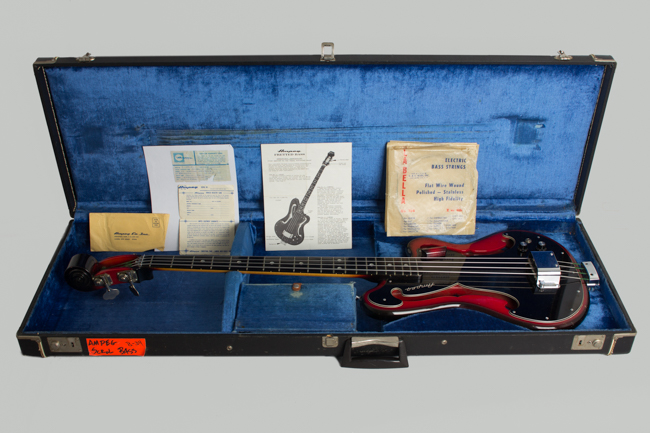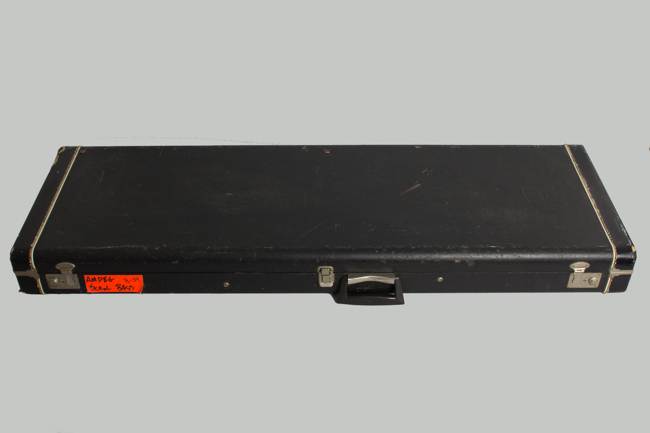Ampeg AEB-1 Electric Bass Guitar (1966)
This item has been sold.
Item # 9089
Prices subject to change without notice.
Ampeg AEB-1 Model Electric Bass Guitar (1966), made in Linden NJ, serial # 340, red/black sunburst finish, laminated maple body, maple neck with ebony fingerboard, original black tolex hard shell case.
This is an exceptionally well-preserved example of a relatively rare instrument: the first version of the fretted Ampeg AEB-1 (Ampeg Electric Bass #1), the company's first production "horizontal" bass. While Ampeg had prospered with amplifiers, they had made only half-hearted attempts to market instruments before 1966, with the fiberglass upright electric "Baby Bass" and importing re-branding quirky Burns of London guitars. These unique Ampeg basses were launched at the 1966 NAMM show with some fanfare, and have become something of a '60s classic, although never becoming serious competition to the Fender Precision or Jazz bass.
The instruments were designed primarily by Ampeg employee Dennis Kager, but some features were the product of company founder Everett Hull's extreme distaste for the Fender bass. Hull was a purist who considered the upright bass to be the only legitimate low end instrument, and wanted to cater to traditional jazz and even classical players! To this end, this first Ampeg "Horizontal Bass" does not have a conventional magnetic pickup. It utilizes the same vibration-activated "Mystery Pickup" located under the bridge as the upright Baby Bass, allowing use of gut strings as well as steel. This point Hull insisted on, much to the chagrin of his employees who knew rock'n'roll players were the mass market. The unique scrolled headstock was another nod to bass tradition.
Ampeg had these instruments in production by late 1966, offering fretted and fretless models designated the AEB-1 and AUB-1. The fretless bass was a genuine innovation, designed to help upright players transition to the electric, the opposite of Fender's "Precision". Unfortunately in the ever higher-volume playing environments of the late 1960s, the rather microphonic and fairly low output pickup proved somewhat impractical and the instrument was re-designed in late 1967 to use a more a conventional magnetic pickup. Pickup oddities aside, the rest of the instrument is extremely well-engineered and quite functional.
This bass is a wonderful example of the first mystery-pickup model. The unusual body is built of laminate woods; the most notable feature is the large open f-holes cut in either side. The maple neck has an ebony fingerboard inlaid with large dots. The bridge unit is made of milled aluminum and is adjustable for height and intonation, with the strings running to a separate heavy tailpiece mounted off the bottom of the body. This setup requires special extra-long strings, although the scale length is the same as a Fender at 34". The serial number is stamped under the tailpiece bar. Even the bridge cover (rarely found intact) is interesting; it has individual foam mutes mounted underneath, and can be slid forward to engage or disengage them.
This bass has a sound somewhere in between a standard bass guitar and an upright. The acoustic-y twang of the "mystery" unit can be mellowed using the volume and tone controls, but it does take some experience to understand how to get a variety of sounds from the instrument.
The original case has more wear than the bass, especially to the ends, but is intact with a wealth of goodies inside. These include the original instruction sheet, warranty card and envelope, adjustment wrenches, and a period cord. The most amazing find is a complete set of original LaBella Hi-Fi flatwound strings, unused new old stock in the original glassine envelopes marked "For Ampeg" by hand, as the bass was new enough the string maker had not yet printed a package for them. These strings are considered by some the best bass strings ever made, and this set is much rarer than even the bass itself! LaBellas of this type must be exactly fitted for length to the bass, as the heavy core wire can be easily broken if wrapped improperly around a tuner...the special Ampeg set would have been made in very limited numbers even when new.
We have not seen another Ampeg "Scroll" bass in this fine condition in a very long time. This is not just a looker, but a very good player and should be of interest to any collector not just of Ampegs but all vintage American basses.
Overall length is 47 in. (119.4 cm.), 14 1/2 in. (36.8 cm.) wide at lower bout, and 1 1/4 in. (3.2 cm.) in depth, measured at side of rim. Scale length is 34 1/2 in. (876 mm.). Width of nut is 1 5/8 in. (41 mm.).
This is the cleanest and most original example of this bass we have seen in a very long time. It has only light finish checking and is mostly free of the cracking and flaking to the lacquer that often plagues these instruments. There is some minor chipping along the back/side seam of the lower treble bout, and a few other spots around the rim; beyond that the bass shows only some very light play wear overall. All hardware is original and complete including the sliding bridge cover and mute bar, which is almost always gone by now.
This bass is not only dead stock, but has very little fret wear and plays perfectly, set up with the heavy flatwound strings that it likes. The case has some scuffing and wear to the outside but it intact and fully functional...and Ampegs will fit in nothing else! This bass is eccentric-sounding for sure, but performs exactly as intended and is simply a superb example of this unique New Jersey creation. Excellent + Condition.
This is an exceptionally well-preserved example of a relatively rare instrument: the first version of the fretted Ampeg AEB-1 (Ampeg Electric Bass #1), the company's first production "horizontal" bass. While Ampeg had prospered with amplifiers, they had made only half-hearted attempts to market instruments before 1966, with the fiberglass upright electric "Baby Bass" and importing re-branding quirky Burns of London guitars. These unique Ampeg basses were launched at the 1966 NAMM show with some fanfare, and have become something of a '60s classic, although never becoming serious competition to the Fender Precision or Jazz bass.
The instruments were designed primarily by Ampeg employee Dennis Kager, but some features were the product of company founder Everett Hull's extreme distaste for the Fender bass. Hull was a purist who considered the upright bass to be the only legitimate low end instrument, and wanted to cater to traditional jazz and even classical players! To this end, this first Ampeg "Horizontal Bass" does not have a conventional magnetic pickup. It utilizes the same vibration-activated "Mystery Pickup" located under the bridge as the upright Baby Bass, allowing use of gut strings as well as steel. This point Hull insisted on, much to the chagrin of his employees who knew rock'n'roll players were the mass market. The unique scrolled headstock was another nod to bass tradition.
Ampeg had these instruments in production by late 1966, offering fretted and fretless models designated the AEB-1 and AUB-1. The fretless bass was a genuine innovation, designed to help upright players transition to the electric, the opposite of Fender's "Precision". Unfortunately in the ever higher-volume playing environments of the late 1960s, the rather microphonic and fairly low output pickup proved somewhat impractical and the instrument was re-designed in late 1967 to use a more a conventional magnetic pickup. Pickup oddities aside, the rest of the instrument is extremely well-engineered and quite functional.
This bass is a wonderful example of the first mystery-pickup model. The unusual body is built of laminate woods; the most notable feature is the large open f-holes cut in either side. The maple neck has an ebony fingerboard inlaid with large dots. The bridge unit is made of milled aluminum and is adjustable for height and intonation, with the strings running to a separate heavy tailpiece mounted off the bottom of the body. This setup requires special extra-long strings, although the scale length is the same as a Fender at 34". The serial number is stamped under the tailpiece bar. Even the bridge cover (rarely found intact) is interesting; it has individual foam mutes mounted underneath, and can be slid forward to engage or disengage them.
This bass has a sound somewhere in between a standard bass guitar and an upright. The acoustic-y twang of the "mystery" unit can be mellowed using the volume and tone controls, but it does take some experience to understand how to get a variety of sounds from the instrument.
The original case has more wear than the bass, especially to the ends, but is intact with a wealth of goodies inside. These include the original instruction sheet, warranty card and envelope, adjustment wrenches, and a period cord. The most amazing find is a complete set of original LaBella Hi-Fi flatwound strings, unused new old stock in the original glassine envelopes marked "For Ampeg" by hand, as the bass was new enough the string maker had not yet printed a package for them. These strings are considered by some the best bass strings ever made, and this set is much rarer than even the bass itself! LaBellas of this type must be exactly fitted for length to the bass, as the heavy core wire can be easily broken if wrapped improperly around a tuner...the special Ampeg set would have been made in very limited numbers even when new.
We have not seen another Ampeg "Scroll" bass in this fine condition in a very long time. This is not just a looker, but a very good player and should be of interest to any collector not just of Ampegs but all vintage American basses.
Overall length is 47 in. (119.4 cm.), 14 1/2 in. (36.8 cm.) wide at lower bout, and 1 1/4 in. (3.2 cm.) in depth, measured at side of rim. Scale length is 34 1/2 in. (876 mm.). Width of nut is 1 5/8 in. (41 mm.).
This is the cleanest and most original example of this bass we have seen in a very long time. It has only light finish checking and is mostly free of the cracking and flaking to the lacquer that often plagues these instruments. There is some minor chipping along the back/side seam of the lower treble bout, and a few other spots around the rim; beyond that the bass shows only some very light play wear overall. All hardware is original and complete including the sliding bridge cover and mute bar, which is almost always gone by now.
This bass is not only dead stock, but has very little fret wear and plays perfectly, set up with the heavy flatwound strings that it likes. The case has some scuffing and wear to the outside but it intact and fully functional...and Ampegs will fit in nothing else! This bass is eccentric-sounding for sure, but performs exactly as intended and is simply a superb example of this unique New Jersey creation. Excellent + Condition.
